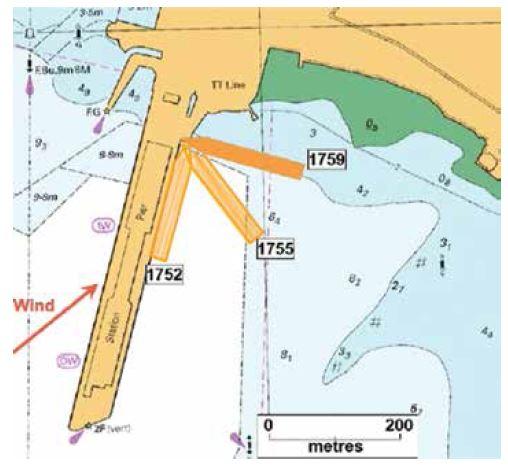201773 Squall gusts break stern moorings
Edited from official report 324-MO-2016-001, Australian Transport Safety Bureau
A ro-ro passenger vessel was docked and crew were loading vehicles and passengers. A strong wind warning was in effect for the area, but at the time of loading winds were steady at about 20 knots. Two of the ship’s four main engines were kept ready for immediate manoeuvring.
Within two minutes the south-westerly wind suddenly increased from about 25 knots to 60 knots. As the wind speed was peaking, the vessel’s aft mooring lines parted in quick succession and its stern broke away from the wharf. As the stern swung away from the wharf the forward breast line came under tension and, along with one head line on the bight, held the vessel’s bow.
Within minutes the Master was able to hold the ship’s stern off the beach using the main propulsion and the fore and aft thrusters. About ten minutes later a tug arrived and was made fast to the ship’s stern. Shortly thereafter a second tug also arrived and began assisting. Within the hour the wind dropped back to about 10 knots and the vessel was returned to the berth.
According to technical analysis, the aft moorings should not have failed, given their nominal breaking strength. Possible reasons for their failure, apart from any unknown defects, could have included:
- Unequal tension in the mooring lines (before the sudden increase in wind speed);
- Not all lines were held on winch brakes (some winches were on selftension mode);
- Sudden dynamic forces (six-fold increase in wind loading);
- Dynamic loading (ship’s momentum as it rapidly moved off the wharf ).
It is possible that the breakaway might have been prevented had the precautions for adverse weather been more carefully considered. For example, had the breast lines been held on winch brakes, the increased static load capacity of the aft mooring line pattern may have prevented the first stern line parting. Similarly, had the ship’s propulsion been ready for immediate use, the stern thruster (maximum 15T transverse thrust) could have been used to counteract some wind loading to prevent the first line parting.
Lessons learned
- Since the wind force varies as the square of the wind speed, small increases in speed translate to large increases in force. In strong winds, gusting amplifies these forces significantly. Strong winds frequently contribute to breakaways;
- Check your mooring lines and ensure they are under equal load proportional to their breaking strength;
- At berth, putting mooring lines on winches and in self-tensioning mode is not best practice. Better to use the winch brake or on bitts as the securing method.

